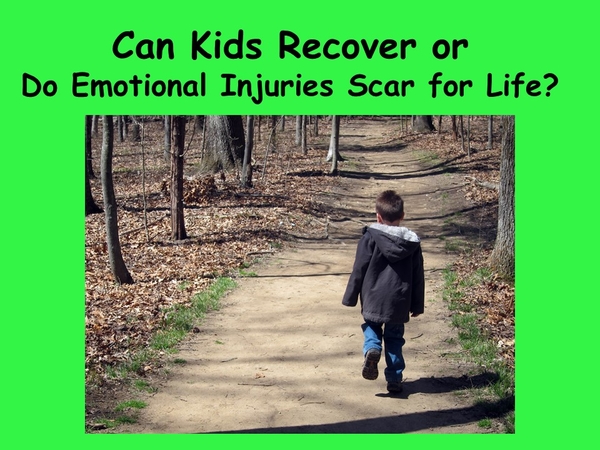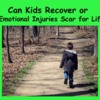Healing Childhood Trauma
I’d like to thank each member of ACE’s Connection for all your work helping and supporting children through various activities and organizations. You are clearly a collection of people who care about the children of the world. It is in recognition of these efforts that I ask you to consider two books on healing childhood trauma. They represent a life-time partnership dedicated to raising and educating healthy children. Secondly, I’d like to ask you for a word of support, vis-a-vis your feedback.
Many years ago, my wife, Barbara, and I devoted our lives to supporting hurt and abandoned children in both our personal and professional lives. We’ve been foster and adoptive parents to children with multiple, special needs. For nearly 30 years, I worked as a school psychologist specializing in intervention, helping parents and teachers understand the consequences of violence, abuse and neglect. Barbara, a social worker by training, has had a full career working with emotionally impaired children, delinquent teens, and adult schizophrenic patients. Many times, we had to learn by ourselves what was unavailable in the literature on trauma and neglect. And many times, we were frustrated and exhausted in our attempts to heal. At home, we lived with the effects of trauma and had no family support, very little from schools, and none from the courts. But through these efforts, we gained valuable knowledge and now see that what we learned could help many people.
I am an applied psychologist, which means that I knew the research and was supposed to translate that technical information into common language, assisting folks in devising interventions that worked. But early on in our careers, little was known about healing traumatized children. Many healthcare professionals felt that these injured innocents could not be healed, especially after the age of five years old. So, minimal resources were devoted to treatment. Schools didn’t understand why these children lied, stole, hoarded, bullied, acted out sexually, and/or had violent episodes of rage. Overwhelmed, under-supported teachers can only do so much, while budget short-falls keep funds away from classroom realities. Teachers lacked the training to meet both the community’s emotional and educational demands simultaneously. Courts could only punish and make matters worse. Professionals believed that after the age of five, most children wouldn’t show any significant, enduring, positive change. Therefore, they questioned the wisdom of investing into treatments most likely to fail.
With little more than our passion to help and the conviction that older children could heal, we jumped in and did our best. Some things we tried worked well, others, not so much. With time, effort, and forgiveness, we were rewarded with many positive outcomes. We learned to intervene in strategic ways in order to redirect growth towards a well-balanced, guilt-free, mental health. We learned to inoculate the injured child against the mental disorders of adulthood at the same time meeting the contemporary challenges they bring to both home and school.
In aiding those who help children in distress, we aim to promote emotional well-being. We have a heart for those who contend with the challenges of trying to raise healthy children despite the odds of succeeding seeming so small.
We know many who have dedicated themselves to serving the greater good. We’ve watched them and recognize their need to passionately believe that all will get better and that they are doing the ‘right’ thing. We know their fears and feel their sense of isolation and exhaustion. It is for this that we stand with them, wishing to comfort and educate. Our experience and knowledge can help them gain the principles of well-being.
Our books are named, Some Way Home: A Memoir in a Myth and Crossing In-finity: Healing Our Children / Ourselves. They contain the core of what works in healing injured children. Some Way Home, our first book, is a passionate story about the successful adoption and restoration of an emotionally devastated child, mistreated since birth and abandoned as a toddler. It reads like a novel and, even though it is based on a real child, it is not meant to be a biography but rather a teaching story (or myth). Our second book, Crossing In-finity, takes a practical look at what heals and what does not. It offers a new way (compatible with ACE’s and Trauma Informed Practices) to look at raising hurt children and proposes behavioral interventions for parents, teachers, and clinicians that allow the child’s own drive towards health to activate in the child. Both publications offer hope and a fresh perspective.
The traumas of early childhood have specific sets of possible consequences on the developing ego. As these consequences have bad effects on their developing personalities in specific ways, these ways are knowable and can be understood. And these children’s development directed back into health. But before we can analyze the dysfunctions caused by early trauma, before ways of healing that trauma can be recommended, we must first have a clear idea about what health is. For without understanding what our intended goal is we may miss it altogether in passing.
Much has been written concerning mental illness. Book after book, edition after edition of working manuals are dedicated to describing what sickness is in profound minutia. As a society, we’ve spent an uncounted fortune in time and money on investigating what we don't want but have given little or no thought to what we do. Our books attempt to improve this imbalance by describing health both first and last.
Thank you for your consideration,
David and Barbara Kenney
p.s. The first twenty folks that can read kindle e-books and who would like copies, please send us your email address and we will send you both for free. All feedback is greatly appreciated and will help us improve our efforts to help.
#kid-epics.com


